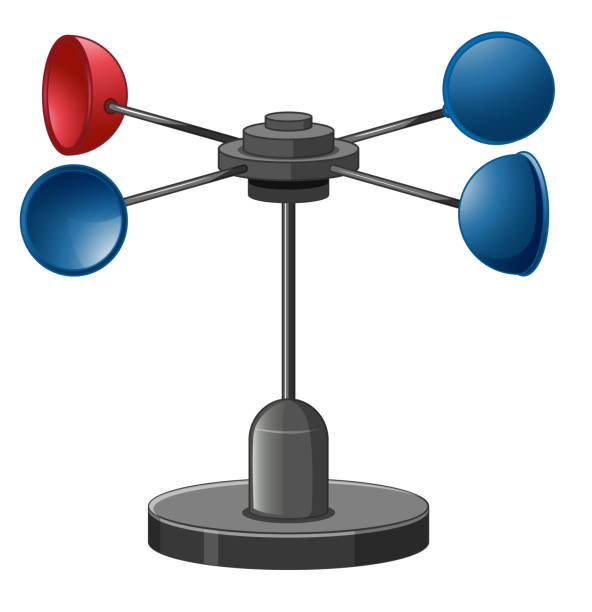All You Need to Understand About Anemometers: Just How They Work, Why They Matter, and Where to Use Them
Anemometers, however commonly overlooked in the realm of scientific tools, play a critical function in different fields, using useful insights right into wind speed and airflow patterns. Understanding the auto mechanics behind these gadgets is necessary for any person seeking to harness the power of this data. From meteorologists tracking weather condition patterns to engineers making structures with wind tons in mind, the applications of anemometers are varied and far-reaching. As we look into the details of anemometer modern technology, we will discover the internal operations of these gadgets, their significance, and the essential considerations when selecting the right anemometer for specific applications.

Anemometer Fundamentals
A vital instrument utilized to measure wind speed and instructions, the anemometer plays a vital duty in weather forecasting and different industries. An anemometer usually is composed of 3 or four mugs that turn in the wind, a vane that directs into the wind, and sensors to track the movements or turnings. By determining the rotations or motions over a details amount of time, the anemometer can identify wind speed. The vane aids determine wind instructions by directing right into the wind, offering important data for climate forecasting, aeronautics, maritime procedures, environmental surveillance, and wind energy applications.
There are numerous sorts of anemometers readily available, including mug anemometers, vane anemometers, hot-wire anemometers, and sonic anemometers, each with its unique attributes and applications. Cup anemometers are generally utilized for standard wind speed dimensions, while vane anemometers are liked for directional measurements. Hot-wire anemometers appropriate for low airspeeds, and sonic anemometers are ideal for high-precision measurements in study and industrial setups. Understanding the fundamentals of anemometers is crucial for precise wind information collection and analysis across different sectors.
Concepts of Anemometer Procedure
Structure on the fundamental understanding of anemometer fundamentals, the principles of anemometer operation illuminate the technicians behind wind rate and direction measurements. Anemometers operate the concept of airflow affecting a sensor, triggering it to turn. Cup anemometers, as an example, have 3 or more cups that capture the wind, causing them to rotate much faster as the wind speed rises. The turning rate is then exchanged a wind speed measurement. Vane anemometers, on the various other hand, make use of a tail or a probe that straightens itself with the wind instructions, giving a measurement of wind direction based upon the alignment of the sensor. Hot-wire anemometers rely upon a heated wire that cools down as wind overlooks it, with the price of cooling down establishing the wind rate. Ultrasonic anemometers step wind rate and instructions by analyzing the moment it considers ultrasonic signals to take a trip between transducers. Comprehending these concepts is vital for reliable and precise wind measurements in different applications.
Value of Anemometers
The relevance of anemometers in weather forecasting and various industries can not be overemphasized. Anemometers play a critical function in gauging wind rate and direction, providing important information for weather condition forecasting, environment studies, ecological monitoring, and air travel operations. Meteorologists depend on anemometers to collect Extra resources precise wind data, assisting them recognize weather condition patterns, anticipate tornados, and concern prompt warnings to the public. In sectors such as building, agriculture, renewable power, and maritime procedures, anemometers are utilized to enhance processes, make certain security, and boost performance. Wind farm drivers make use of anemometers to assess wind conditions and make best use of electrical energy manufacturing from wind turbines. In the maritime field, anemometers help ship navigating by offering real-time wind info to captains, assisting them make informed choices to make sure safe voyages. In general, anemometers are crucial tools that contribute considerably to safety, efficiency, and notified decision-making in meteorology and a vast array of industries.
Applications Across Numerous Industries
In the sustainable energy market, anemometers play a critical duty in evaluating wind conditions for wind find out here ranch placements, guaranteeing optimal energy production. Industries like building and construction and mining utilize anemometers to keep track of wind speeds, essential for safety methods, particularly when working at heights or in open-pit mines where strong winds can posture risks. In agriculture, anemometers assist farmers in taking care of crop splashing by providing real-time data on wind speed to avoid drift.

Choosing the Right Anemometer for Your Requirements
Picking the proper anemometer customized to your specific demands is important for acquiring exact wind speed and direction measurements. When selecting an anemometer, consider factors such as the designated application, needed dimension array, environmental problems, and desired features. For general functions, a mug anemometer appropriates for measuring wind rate, while a vane anemometer gives wind direction information. Hot-wire anemometers are perfect for low airspeed measurements, and ultrasonic anemometers offer high accuracy and durability.

Final Thought
In verdict, anemometers play a critical role in gauging wind rate and instructions across different markets. It is important to take into consideration the significance of anemometers in order to make educated choices when choosing the most ideal gadget for gauging wind conditions.
There are different kinds of anemometers readily available, including mug anemometers, vane anemometers, hot-wire anemometers, and sonic anemometers, each with its unique features and applications. Cup anemometers are typically made use of for basic wind speed measurements, while vane anemometers are liked for directional measurements. Hot-wire anemometers are suitable for reduced airspeeds, and sonic anemometers are optimal for high-precision dimensions in research study and commercial setups.Structure Continued on the foundational understanding of anemometer fundamentals, the principles of anemometer procedure clarify the mechanics behind wind speed and direction measurements. For basic purposes, a cup anemometer is appropriate for determining wind rate, while a vane anemometer provides wind direction information.
Comments on “How an Anemometer Can Boost Your Weather Monitoring System”